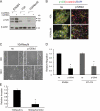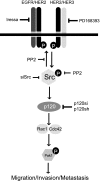HER2/ErbB2-induced breast cancer cell migration and invasion require p120 catenin activation of Rac1 and Cdc42
- PMID: 20595387
- PMCID: PMC2937981
- DOI: 10.1074/jbc.M110.136770
HER2/ErbB2-induced breast cancer cell migration and invasion require p120 catenin activation of Rac1 and Cdc42
Abstract
Breast cancers that overexpress the receptor tyrosine kinase ErbB2/HER2/Neu result in poor patient outcome because of extensive metastatic progression. Herein, we delineate a molecular mechanism that may govern this malignant phenotype. ErbB2 induction of migration requires activation of the small GTPases Rac1 and Cdc42. The ability of ErbB2 to activate these small GTPases necessitated expression of p120 catenin, which is itself up-regulated by signaling through ErbB2 and the tyrosine kinase Src. Silencing p120 in ErbB2-dependent breast cancer cell lines dramatically inhibited migration and invasion as well as activation of Rac1 and Cdc42. In contrast, overexpression of constitutively active mutants of these GTPases reversed the effects of p120 silencing. Lastly, ectopic expression of p120 promoted migration and invasion and potentiated metastatic progression of a weakly metastatic, ErbB2-dependent breast cancer cell line. These results suggest that p120 acts as an obligate intermediate between ErbB2 and Rac1/Cdc42 to modulate the metastatic potential of breast cancer cells.
Figures








Similar articles
-
Cdc42 GTPase and Rac1 GTPase act downstream of p120 catenin and require GTP exchange during gastrulation of zebrafish mesoderm.Dev Dyn. 2012 Oct;241(10):1545-61. doi: 10.1002/dvdy.23847. Epub 2012 Sep 4. Dev Dyn. 2012. PMID: 22911626
-
Rac1 and Cdc42 differentially modulate cigarette smoke-induced airway cell migration through p120-catenin-dependent and -independent pathways.Am J Pathol. 2013 Jun;182(6):1986-95. doi: 10.1016/j.ajpath.2013.02.008. Epub 2013 Apr 2. Am J Pathol. 2013. PMID: 23562274 Free PMC article.
-
Abnormal expression of p120-catenin, E-cadherin, and small GTPases is significantly associated with malignant phenotype of human lung cancer.Lung Cancer. 2009 Mar;63(3):375-82. doi: 10.1016/j.lungcan.2008.12.012. Epub 2009 Jan 21. Lung Cancer. 2009. PMID: 19162367
-
Protein kinase C α enhances migration of breast cancer cells through FOXC2-mediated repression of p120-catenin.BMC Cancer. 2017 Dec 7;17(1):832. doi: 10.1186/s12885-017-3827-y. BMC Cancer. 2017. PMID: 29216867 Free PMC article.
-
Ablation of p120-catenin enhances invasion and metastasis of human lung cancer cells.Cancer Sci. 2009 Mar;100(3):441-8. doi: 10.1111/j.1349-7006.2008.01067.x. Epub 2008 Dec 22. Cancer Sci. 2009. PMID: 19154401 Free PMC article.
Cited by
-
Interaction of p190RhoGAP with C-terminal domain of p120-catenin modulates endothelial cytoskeleton and permeability.J Biol Chem. 2013 Jun 21;288(25):18290-9. doi: 10.1074/jbc.M112.432757. Epub 2013 May 7. J Biol Chem. 2013. PMID: 23653363 Free PMC article.
-
The involvement of JAK-STAT3 in cell motility, invasion, and metastasis.JAKSTAT. 2014 Jan 1;3(1):e28086. doi: 10.4161/jkst.28086. Epub 2014 Feb 20. JAKSTAT. 2014. PMID: 24778926 Free PMC article. Review.
-
Cyclin-dependent kinase 5 promotes the stability of corneal epithelial cell junctions.Mol Vis. 2013;19:319-32. Epub 2013 Feb 7. Mol Vis. 2013. PMID: 23401660 Free PMC article.
-
Divergent behaviors and underlying mechanisms of cell migration and invasion in non-metastatic T24 and its metastatic derivative T24T bladder cancer cell lines.Oncotarget. 2015 Jan 1;6(1):522-36. doi: 10.18632/oncotarget.2680. Oncotarget. 2015. PMID: 25402510 Free PMC article.
-
Cellular polarity pilots breast cancer progression and immunosuppression.Oncogene. 2025 Apr;44(12):783-793. doi: 10.1038/s41388-025-03324-0. Epub 2025 Mar 8. Oncogene. 2025. PMID: 40057606 Free PMC article. Review.
References
Publication types
MeSH terms
Substances
Grants and funding
LinkOut - more resources
Full Text Sources
Other Literature Sources
Medical
Research Materials
Miscellaneous

